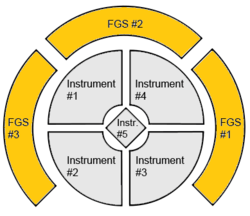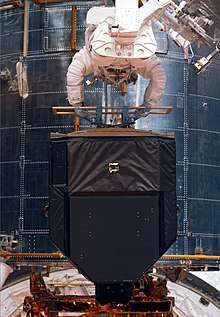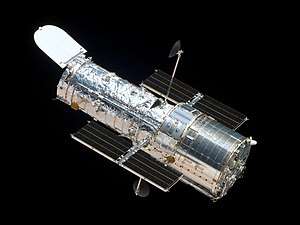Fine Guidance Sensor (HST)
Fine Guidance Sensor (FGS) for the Hubble Space Telescope is a system of three instruments used for pointing the telescope in space, and also for astrometry and its related sciences.[2] Each FGS uses a combination of optics and electronics to provide for pointing the telescope at a certain location in the sky.[2] There are three Hubble FGS, and they have been upgraded over the lifetime of the telescope by manned Space Shuttle missions.[3] The instruments can support pointing of 2 milli-arc seconds (units of degree).[4] The three FGS are part of the Hubble Space Telescope's Pointing Control System, aka PCS.[5] The FGS function in combination with the Hubble main computer and gyroscopes, with the FGS providing data to the computer as sensors which enables the HST to track astronomical targets.[6]


The FGS can be used to locate something in space, and then lock-on to it.[7] It can provide the movements the telescope must make to keep the object in view, for the main instruments to record data on.[8]
The FGS were originally made by the optics company Perkin-Elmer, and as removable and repairable instruments it has been possible to refurbish them over the lifetime of the telescope.[8] The first replacement FGS was installed in 1997, swapping out FGS1.[5]
In May 2009, on STS-125 a FGS was replaced during the mission to the Hubble telescope by the Space Shuttle.[9] The astronaut crew performed an EVA (spacewalk) to service the FGS and other components on the telescope in Earth orbit.[9] This was the SM4 mission.[6]
An example of astrometry science with the Hubble FGS system is observations of the Low-Mass Binary star system L722-22.[10] Observations were taken of the system in 1990s, and the data helped determine the mass of each of the components of L722-22, which is also known as LHS 1047 and GJ 1005.[10]
The FGS are white-light shearing interferometers.[5] The FGS weigh 220 kg (485 lb) and have dimensions of roughly 0.5 m × 1.0 m × 1.6 meters.[11]
Observations
The smallest KBO yet detected at that time was discovered in 2009 by poring over data from the Hubble Space Telescope's fine guidance sensors.[12] They detected a transit of an object against a distant star, which, based on the duration and amount of dimming, was calculated to be a KBO about 1,000 meters (3,200 ft) in diameter.[12] It has been suggested that the Kepler observatory may be able to detect objects in the Oort cloud by their occultation of background stars,[13] and the Whipple proposal would also try to use this concept
A Hubble FGS has also been used for astrometry, tracking the movement of different starts.[14] This ability was used for exoplanet research, where the motion of the star caused by the movement of planets around it was detected.[15] Hubble was used via the FGS sensors to detect the motion of star caused by an exoplanet orbiting it.[16] The effect on the Star Gliese 876's by companion Gliese 876b was measured.[17] That star is known as a red dwarf about 15 light-years away from Earth.[18]
FGS was used to study Double-star systems (aka Binary star systems) and to measure distances to astronomical bodies.[19]
FGS has also been used to observer asteroids and calculate their size.[20] Asteroids studied include (63) Ausonia, (15) Eunomia, (43) Ariadne, (44) Nysa, and (624) Hektor.[21]
See also
- Fine Guidance Sensor and Near Infrared Imager and Slitless Spectrograph (FGS for JWST)
- Guide Star Catalog (Hubble)
- Whipple (spacecraft) (Occulation type Space telescope concept)
- Kepler (spacecraft) (Space telescope)
- Fine guidance sensor
References
- information@eso.org. "Hubble's Instruments: FGS - Fine Guidance Sensors". www.spacetelescope.org. Retrieved 2017-03-03.
- "NASA - Refurbished Fine Guidance Sensor (FGS)". www.nasa.gov. Retrieved 2017-03-03.
- Fine Guidance Sensors Aboard the Hubble Space Telescope, the Scientific Capabilities of these Interferometer
- "NASA - Hubble Space Telescope Servicing Mission 4
Fine Guidance Sensor". www.nasa.gov. Retrieved 2017-03-03. - "Fine guidance sensors: Hubble's unsung heros". NewsTimes. Retrieved 2017-04-12.
- "Fine guidance sensors: Hubble's unsung heros". NewsTimes. Retrieved 2017-03-03.
- "Photo Index 1". spaceflight.nasa.gov. Retrieved 2017-03-03.
- Hershey, John L.; Taff, L. G. (1998-01-01). "Hubble Space Telescope Fine Guidance Sensor Astrometry of the Low-Mass Binary L722-22". The Astronomical Journal. 116 (3): 1440. Bibcode:1998AJ....116.1440H. doi:10.1086/300516. ISSN 1538-3881.
- "Hubble instruments". sci.esa.int. Retrieved 2017-03-03.
- DETECTABILITY OF OORT CLOUD OBJECTS USING KEPLER - 2009
- ""Out of Whack" Planetary System Offers Clues to a Disturbing Past". UT News | The University of Texas at Austin. 2010-05-24. Retrieved 2018-01-28.
- ""Out of Whack" Planetary System Offers Clues to a Disturbing Past". UT News | The University of Texas at Austin. 2010-05-24. Retrieved 2018-01-28.
- Gliese 876
- Tanga, P.; Hestroffer, D.; Cellino, A.; Lattanzi, M.; Martino, M. Di; Zappalà, V. (2003-04-01). "Asteroid observations with the Hubble Space Telescope FGS". Astronomy & Astrophysics. 401 (2): 733–741. Bibcode:2003A&A...401..733T. doi:10.1051/0004-6361:20030032. ISSN 0004-6361.
- Tanga, P.; Hestroffer, D.; Cellino, A.; Lattanzi, M.; Martino, M. Di; Zappalà, V. (2003-04-01). "Asteroid observations with the Hubble Space Telescope FGS". Astronomy & Astrophysics. 401 (2): 733–741. Bibcode:2003A&A...401..733T. doi:10.1051/0004-6361:20030032. ISSN 0004-6361.

